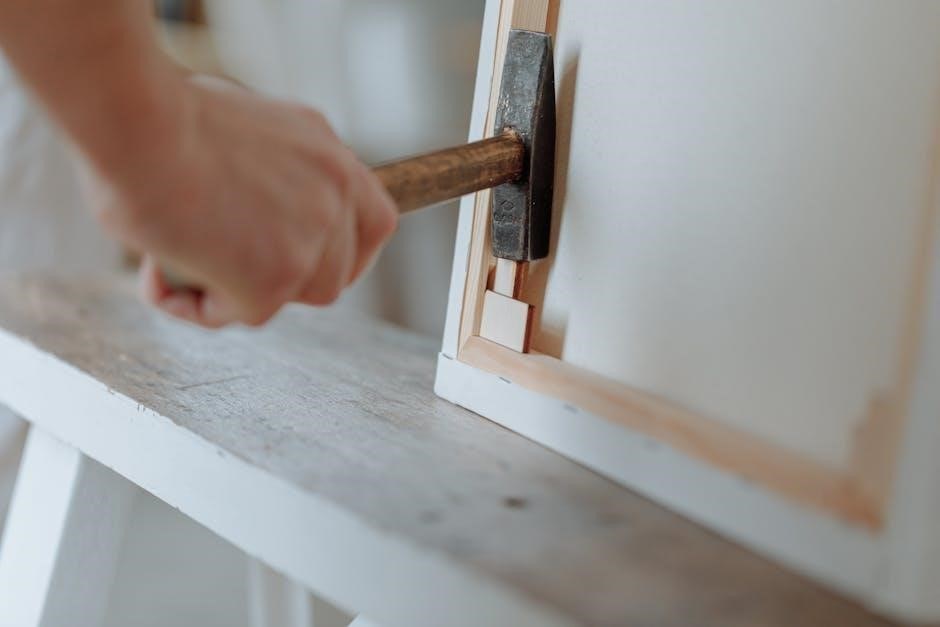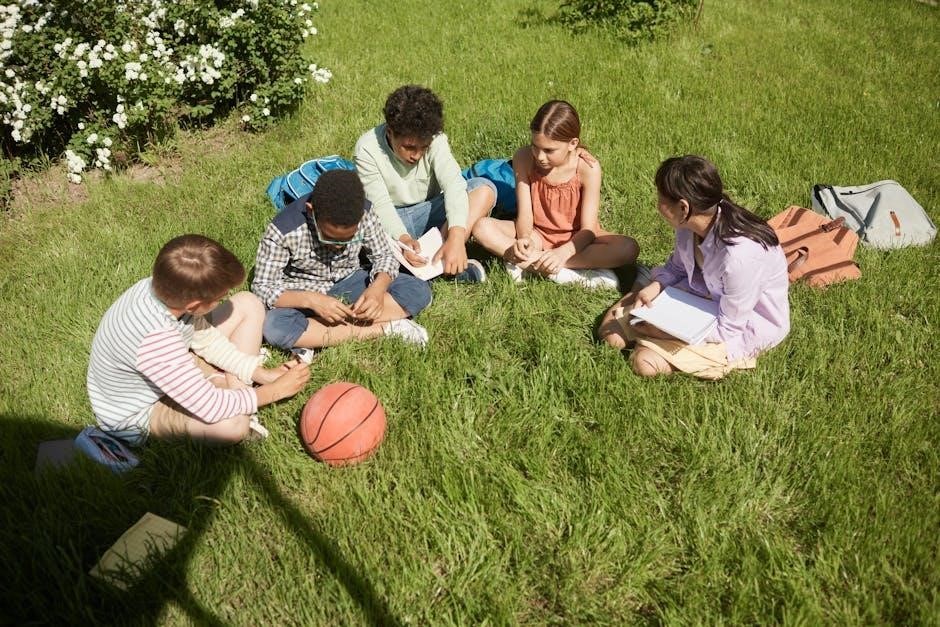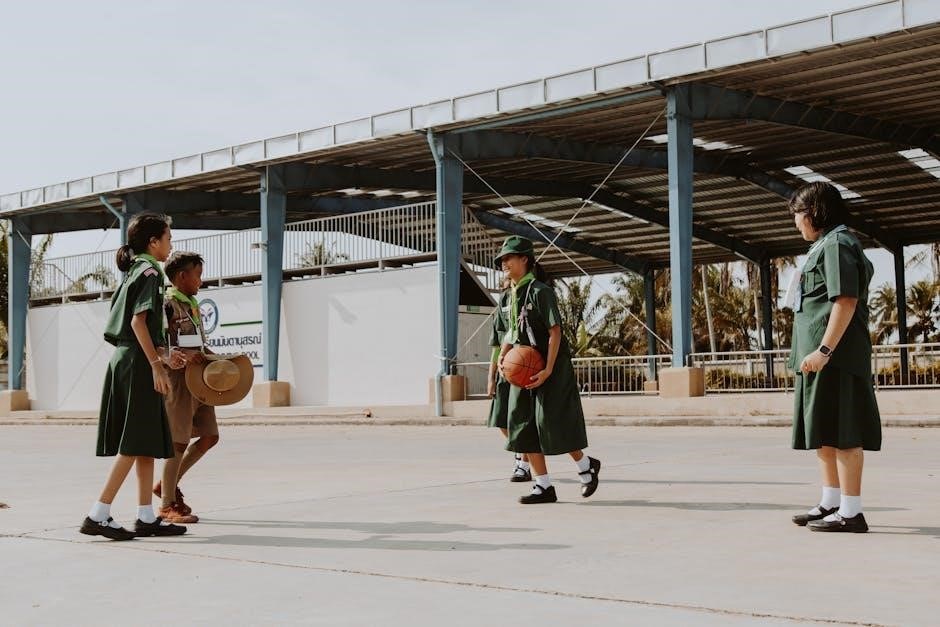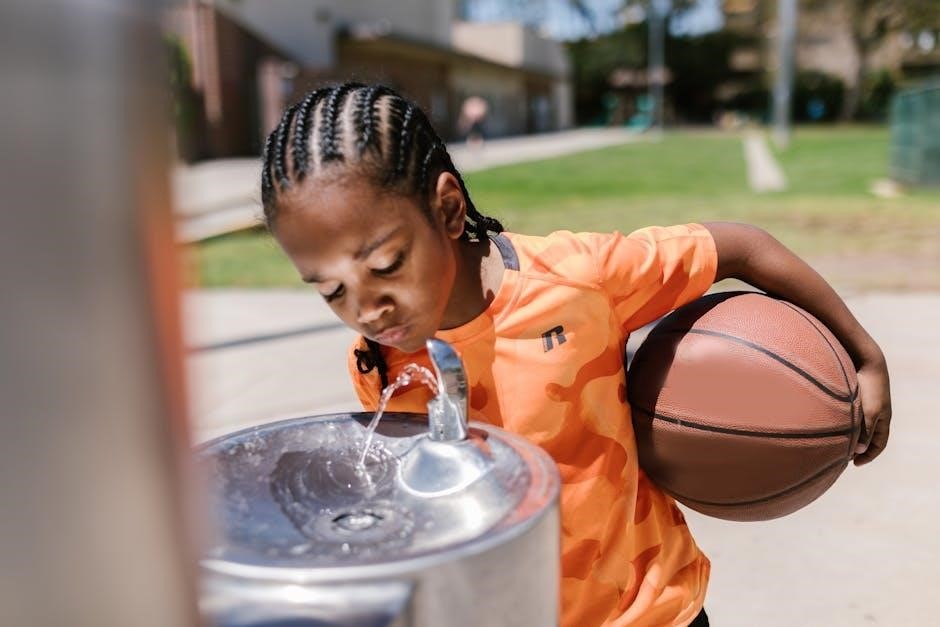
Manual High School Basketball serves as a foundational guide for players, coaches, and enthusiasts, focusing on strategies, skill development, and teamwork to excel in the sport.
1.1 Brief History of Manual High School Basketball
Manual High School Basketball traces its roots back to the early 20th century, emerging as a cornerstone of the school’s athletic program. The team quickly gained prominence, with its first championship win in the 1950s. Over the decades, the program became known for producing talented players and fostering a competitive spirit. The 1970s and 1980s saw peak success, including multiple state titles. Today, Manual High School Basketball remains a symbol of pride, blending tradition with modern strategies to inspire future generations of athletes and fans alike.
1.2 Importance of a Manual in High School Basketball
A manual is essential for organizing and standardizing high school basketball programs, providing a structured approach to training, strategy, and player development. It ensures consistency in coaching methods, helping players and staff align with shared goals. The manual serves as a reference guide for understanding rules, drills, and game tactics, fostering teamwork and discipline. By detailing roles and responsibilities, it streamlines communication and decision-making, creating a cohesive environment for success. Ultimately, a well-crafted manual is vital for building a competitive, skilled, and unified basketball team capable of achieving its full potential on and off the court.

Understanding the Game Basics
Mastering the fundamentals of basketball is crucial for success. This section covers essential rules, skills, and court awareness, providing a solid foundation for players to build upon their abilities effectively.
2.1 Rules and Regulations of High School Basketball
High school basketball rules are designed to ensure fair play and safety. Games are divided into four quarters, each lasting 8 minutes in varsity play. Fouls, such as holding or tripping, result in free throws or possession. A personal foul limit of 5 fouls per player prevents disqualification. Equipment must meet safety standards, and court dimensions are standardized. Key rules include the shot clock, backcourt violation, and three-point line. Referees enforce rules, and sportsmanship is emphasized. Understanding these regulations is essential for players, coaches, and officials to maintain a competitive and respectful game environment.
2.2 Essential Skills for Players
Mastering fundamental basketball skills is crucial for player success. Dribbling, including stationary and moving drills, enhances ball control and court navigation. Shooting accuracy, from free throws to three-pointers, is vital for scoring efficiency. Passing skills, such as chest and bounce passes, ensure effective teamwork and scoring opportunities. Defensive techniques, like staying low and anticipating, help players excel on both ends. Footwork, including pivots and crossovers, improves positioning and agility. Developing a high basketball IQ enables players to make smart decisions quickly. Rebounding, both offensive and defensive, secures possessions and creates second-chance points. Building stamina and agility ensures players can maintain performance throughout the game.
2.3 Positions and Roles on the Court
In high school basketball, each player has a defined role based on their position. The center typically dominates rebounds and defends the rim, while the power forward balances scoring and rebounding. The small forward is often the most versatile player, excelling in scoring, rebounding, and defense. The shooting guard focuses on perimeter scoring and creating offensive opportunities, and the point guard acts as the team’s playmaker, orchestrating offense and maintaining ball control. Understanding and executing these roles effectively is essential for team success, as each position contributes uniquely to the overall strategy and performance on the court.

Offensive Strategies
Offensive strategies in high school basketball involve fast breaks, set plays, and isolations to create scoring opportunities and exploit defensive weaknesses effectively.
3.1 Key Offensive Plays and Setups
Key offensive plays and setups in high school basketball are designed to create scoring opportunities through structured movements and player coordination. Common strategies include the pick-and-roll, isolation plays, and motion offenses. These setups aim to exploit defensive weaknesses by utilizing ball movement, player positioning, and timing. Coaches often incorporate drills like the give-and-go and fast-break exercises to improve offensive efficiency. Player development techniques, such as ball handling and shooting exercises, are also essential to enhance individual skills within these offensive systems. Effective execution of these plays relies on teamwork, communication, and adaptability to defensive pressure.
3.2 Drills to Improve Scoring Efficiency
Drills to improve scoring efficiency focus on enhancing players’ ability to convert opportunities into points. Essential exercises include shooting drills, such as spot-up and off-the-dribble shots, to build accuracy. Ball-handling drills, like figure-eight and crossovers, improve control and decision-making. Cutting and finishing drills, such as layup lines and euro steps, refine players’ ability to score in traffic. Team-oriented exercises, like the give-and-go and fast-break drills, emphasize timing and coordination. These drills, combined with strength training and film study, help players develop the skills and confidence needed to excel in high-pressure scoring situations.
3.3 Player Development Techniques
Player development techniques focus on enhancing individual and team performance through targeted training. Coaches use personalized workout plans to address specific skill gaps, ensuring each player improves efficiently. Regular skill assessments help track progress and identify areas needing attention. Mental preparation, such as visualization and mindfulness exercises, builds confidence and focus. Strength and conditioning programs improve physical endurance and reduce injury risks. Team-building activities foster camaraderie and trust, essential for cohesive play; By combining these methods, players develop holistically, becoming versatile and resilient contributors to the team’s success.

Defensive Strategies
Defensive strategies in basketball focus on disrupting opponents’ offenses and protecting the basket. Techniques include man-to-man and zone defenses, pressuring the ball, and contesting shots effectively.
4.1 Fundamental Defensive Techniques
Fundamental defensive techniques are essential for building a strong defensive foundation. These include proper stance, footwork, and positioning to stay balanced and active. Players should focus on staying low, with knees slightly bent and hands up, to maintain agility and reaction time. Footwork techniques like slides and closeouts help defenders stay in front of opponents and contest shots or passes effectively. Additionally, active hands and body positioning can disrupt offensive players without fouling. Communication and teamwork are also critical, ensuring all defenders are aware of their responsibilities and can provide help when needed. Mastering these basics is key to individual and team success.
4.2 Advanced Defensive Schemes
Advanced defensive schemes involve complex strategies to disrupt opponents’ offenses. These include man-to-man presses, zone defenses, and help-side rotations to anticipate and intercept passes. Switching on screens and trapping in specific areas can limit scoring opportunities. Teams may also employ matchup zones to combine individual and zone principles. Communication and anticipation are critical, as players must read the offense and react swiftly. These schemes require higher levels of teamwork, discipline, and adaptability. They are often used in critical game situations to create turnovers or disrupt rhythm without fouling, ensuring smart positioning and timing to outsmart opponents effectively.
4.4 Defensive Drills and Training Methods
Defensive drills are essential for building a strong, cohesive unit. Sliding drills improve lateral movement, while defensive stance exercises enhance balance and reaction time. Partner drills, such as closeouts and contesting shots, simulate game-like scenarios. Team drills, like shell defense and help-side rotations, focus on communication and coordination. Controlled scrimmages allow players to apply defensive strategies in live situations. Film study and feedback sessions help refine techniques, ensuring players understand their roles. These methods foster discipline, anticipation, and teamwork, preparing the defense to adapt to various offensive strategies effectively during games. Consistent practice strengthens defensive execution and mental toughness.

Practice Organization and Planning
Effective practice planning involves setting clear goals, managing time efficiently, and balancing skill development, conditioning, and strategic preparation to maximize player and team improvement.
5.1 Structuring Effective Practices
Structuring effective practices involves creating a balanced and dynamic schedule that focuses on skill development, teamwork, and physical conditioning. Coaches should set clear objectives for each session, ensuring alignment with the team’s long-term goals. Begin with a thorough warm-up to prevent injuries and prepare players mentally and physically. Incorporate drills that target specific skills, such as dribbling, shooting, and defense, while integrating game-like scenarios to enhance decision-making. Allocate time for scrimmages to apply strategies in real-time. Effective practices also include feedback sessions and cool-down activities to foster growth and camaraderie. Adapt the structure based on player progress and upcoming game strategies.
5.2 Conditioning and Strength Training
Conditioning and strength training are essential for enhancing player performance and reducing injury risks. A well-designed program focuses on improving endurance, agility, and muscular strength. Incorporate cardio exercises like sprints and shuttle runs to boost stamina. Strength training, such as weightlifting and bodyweight exercises, helps build power and stability. Flexibility and mobility drills, including stretching, ensure optimal movement. Proper nutrition and hydration are emphasized to fuel workouts and aid recovery. Coaches should tailor programs to individual needs and monitor progress to ensure safe and effective development. A balanced approach to conditioning prepares players for the physical demands of the game.
5.3 Incorporating Film Study into Practices
Incorporating film study into practices enhances player and team performance by analyzing game footage. Coaches can identify strengths, weaknesses, and areas for improvement, enabling strategic adjustments. Players gain insights into their techniques and decision-making, fostering growth. Tools like video analysis software help break down plays and opponent strategies, preparing teams for future games. Regular film review sessions improve understanding of the game, boost teamwork, and refine execution. This method bridges the gap between practice and competition, ensuring a data-driven approach to success.

In-Game Strategies
In-game strategies involve adjusting plays, managing timeouts, and adapting to opponents’ tactics, ensuring dynamic decision-making to maximize scoring opportunities and maintain momentum throughout the game.

6;1 Play Calling and Adjustments
Effective play calling and adjustments are pivotal in high school basketball, enabling teams to respond dynamically to game situations. Coaches must read the game flow, identify defensive weaknesses, and signal plays that exploit these opportunities. Players should be trained to execute set plays efficiently while adapting to defensive pressures. Adjustments often involve switching strategies mid-game, such as shifting from man-to-man to zone defense or altering scoring approaches. Clear communication and quick decision-making are crucial, ensuring the team remains competitive and capitalized on scoring chances throughout the game.
6.2 Managing Game Clock and Timeouts
Managing the game clock and timeouts is a critical strategic aspect of high school basketball. Coaches must balance resting players, stopping momentum, and setting up crucial plays. Effective timeout usage ensures teams regroup and adjust strategies mid-game. Late-game scenarios often hinge on precise clock management, such as milking the clock to preserve a lead or rushing to score before the buzzer. Clear communication and preparedness are essential, as players must understand time-sensitive situations and execute plays efficiently. Proper management of timeouts and the game clock can significantly influence the outcome, turning close games into victories.
6.3 Adapting to Opponent’s Strategies
Adapting to an opponent’s strategies is crucial for success in high school basketball. Coaches and players must remain flexible, analyzing the opponent’s strengths and weaknesses during the game. Adjustments can include switching defensive schemes, exploiting vulnerabilities, or modifying offensive plays to counter their approach. Effective communication and quick decision-making are key to outsmarting opponents. Teams that adapt efficiently can neutralize the opponent’s advantages and capitalize on their mistakes. Staying calm and focused under pressure ensures smarter decisions, leading to better outcomes and a competitive edge in high-stakes situations.

Player Development
Player development focuses on enhancing individual and team capabilities through targeted training, skill refinement, and mental conditioning. It emphasizes practice, dedication, and continuous improvement for optimal performance.
7.1 Improving Individual Skills
Improving individual skills is crucial for player development in Manual High School Basketball. Coaches and players should focus on fundamental drills to enhance dribbling, shooting, and passing. Breaking down skills into smaller, manageable components allows for targeted practice and mastery. Incorporating skill-specific exercises like cone drills for agility and free-throw shooting routines can significantly improve performance. Additionally, players should prioritize mental preparation through visualization and focus exercises. Regular film study helps identify areas for improvement, enabling tailored training plans. By combining consistent practice with personalized development strategies, players can achieve measurable progress and elevate their game.
7.2 Building Team Chemistry
Building team chemistry is essential for fostering a cohesive and competitive Manual High School Basketball team. Coaches should emphasize open communication, encouraging players to share ideas and support one another. Trust-building activities, such as team bonding exercises and collaborative drills, help strengthen relationships. Players should understand their roles and work together seamlessly, creating a sense of unity. Regular team meetings and feedback sessions also promote accountability and alignment toward shared goals. By nurturing a positive team culture, players develop a collective mindset, enhancing both performance and camaraderie on and off the court.
7.3 Mental Preparation and Focus
Mental preparation is crucial for peak performance in Manual High School Basketball. Players should practice visualization techniques to stay focused and calm under pressure. Developing a pre-game routine, such as deep breathing or positive self-talk, helps maintain concentration. Coaches can incorporate mindfulness exercises to enhance team cohesion and mental clarity. Setting clear, achievable goals fosters determination and direction. Encouraging players to review game footage and analyze their performance improves focus and decision-making. A mentally prepared team is better equipped to adapt to challenges, stay resilient, and perform at their best during critical moments of the game.

Team Management
Effective team management in Manual High School Basketball involves clear communication, defined roles, and conflict resolution to ensure a cohesive and successful team environment through strong collaboration.
8.1 Roles of Coaches and Assistants
In Manual High School Basketball, coaches and assistants play pivotal roles in team success. Coaches develop game strategies, oversee practices, and inspire players to reach their potential. Assistants support coaches by managing drills, analyzing opponents, and providing individual player feedback. Together, they foster a culture of discipline, teamwork, and continuous improvement. Effective communication and collaboration between coaches and assistants ensure a unified approach to training and competition, ultimately enhancing the team’s performance and overall success in high school basketball.
8.2 Effective Communication Strategies
Effective communication is crucial for success in Manual High School Basketball. Coaches and players must maintain clear, concise, and respectful dialogue to ensure understanding and alignment. Active listening, feedback, and adaptability are key components of strong communication. Positive reinforcement and constructive criticism help build confidence and improve performance. Regular team meetings and one-on-one discussions foster transparency and trust. Coaches should tailor communication strategies to individual player needs while emphasizing teamwork. By promoting open and consistent communication, the team can address challenges, build unity, and achieve shared goals effectively. Clear messaging ensures everyone is aligned and working toward the same objectives.
8.3 Managing Player Conflicts
Managing player conflicts is essential to maintain a cohesive and productive team environment in Manual High School Basketball. Conflicts often arise from differing opinions, competitive pressures, or personal tensions. Coaches and leaders must address these issues promptly and fairly to prevent escalation. Encouraging open dialogue, active listening, and respect fosters resolution. Establishing clear expectations and consequences helps minimize disputes. Mediation and team-building activities can strengthen relationships and improve communication. Addressing conflicts constructively ensures the team remains united, focused, and committed to shared goals. A positive, inclusive culture reduces friction and enhances overall performance. Conflict resolution is a key component of successful team management.

Game Analysis and Review
Game analysis and review are essential for improving performance. Coaches evaluate footage to identify strengths, weaknesses, and areas needing adjustment. This process enhances strategic planning and player development.
9.1 Analyzing Game Footage
Analyzing game footage is a critical component of improving performance in high school basketball. Coaches and players review recordings to identify strengths, weaknesses, and areas for improvement. By studying opponent strategies, teams can adapt their tactics. Footage analysis helps refine offensive and defensive plays, enhancing overall execution. It also allows for evaluating player positioning, decision-making, and teamwork. Advanced tools, like video software, enable frame-by-frame breakdowns, providing insights into game dynamics. This process fosters informed adjustments and strategic planning, ensuring continuous growth and competitive edge on the court. Regular review of game footage is essential for maximizing potential and achieving success.
9.2 Identifying Strengths and Weaknesses
Identifying strengths and weaknesses is vital for improving team and individual performance in high school basketball. Coaches analyze player skills, such as shooting, dribbling, and defense, to pinpoint areas of excellence and improvement. Statistical data and game observations help assess effectiveness. Strengths, like consistent free-throw shooting or strong rebounding, are leveraged to enhance strategies. Weaknesses, such as poor ball handling or defensive lapses, are addressed through targeted drills and practice. Understanding these aspects allows for better player development and strategic adjustments, ensuring a balanced and competitive team performance. This process fosters growth and prepares players for challenging matchups.
9.3 Implementing Post-Game Adjustments
Post-game adjustments are crucial for enhancing team performance in high school basketball. Coaches review game footage to identify mistakes and areas for improvement. Players receive feedback on their execution, highlighting both successes and lapses. A corrective action plan is developed, focusing on refining skills and strategies. Practices are tailored to address specific weaknesses, such as defensive lapses or offensive inefficiencies. Coaches also adapt game strategies to better align with the team’s strengths and opponents’ vulnerabilities. Open communication ensures players understand their roles and responsibilities. These adjustments foster continuous improvement, preparing the team for upcoming challenges and fostering long-term success.
Manual High School Basketball offers a comprehensive guide to success, emphasizing skill mastery, strategic play, and teamwork. Continuous improvement ensures future triumphs on and off the court.
10.1 Summary of Key Takeaways
Manual High School Basketball emphasizes a holistic approach to the game, blending skill development, strategic execution, and teamwork. Players should focus on mastering fundamentals, adapting to situational strategies, and fostering mental toughness. Coaches play a pivotal role in creating structured practices, fostering team chemistry, and making in-game adjustments. Continuous learning, film analysis, and conditioning are essential for long-term success. By prioritizing player growth and strategic adaptability, teams can achieve both competitive excellence and personal development, ensuring a bright future for high school basketball programs.
10.2 Preparing for Future Seasons
Preparing for future seasons involves a combination of off-season training, strategic planning, and program development. Coaches should focus on identifying and nurturing young talent while refining team systems. Players must commit to conditioning and skill enhancement during breaks to maintain competitiveness. Additionally, analyzing past performances helps pinpoint areas for improvement. Building a strong team culture and fostering leadership among returning players can create a solid foundation. Engaging with the community and alumni can also provide resources and support. By prioritizing long-term development and adaptability, Manual High School Basketball can ensure sustained success and a legacy of excellence.
10.3 Continuous Improvement in High School Basketball
Continuous improvement in high school basketball requires a commitment to adaptability, innovation, and growth. Coaches and players must stay updated on evolving strategies and techniques. By analyzing game footage and incorporating feedback, teams can refine their performance. Player development programs should focus on enhancing individual and collective skills. Additionally, fostering a culture of accountability and resilience ensures long-term success. Leveraging resources like clinics, camps, and expert advice can further elevate the program. Ultimately, continuous improvement involves a dedication to learning, collaboration, and striving for excellence at every level of the game.